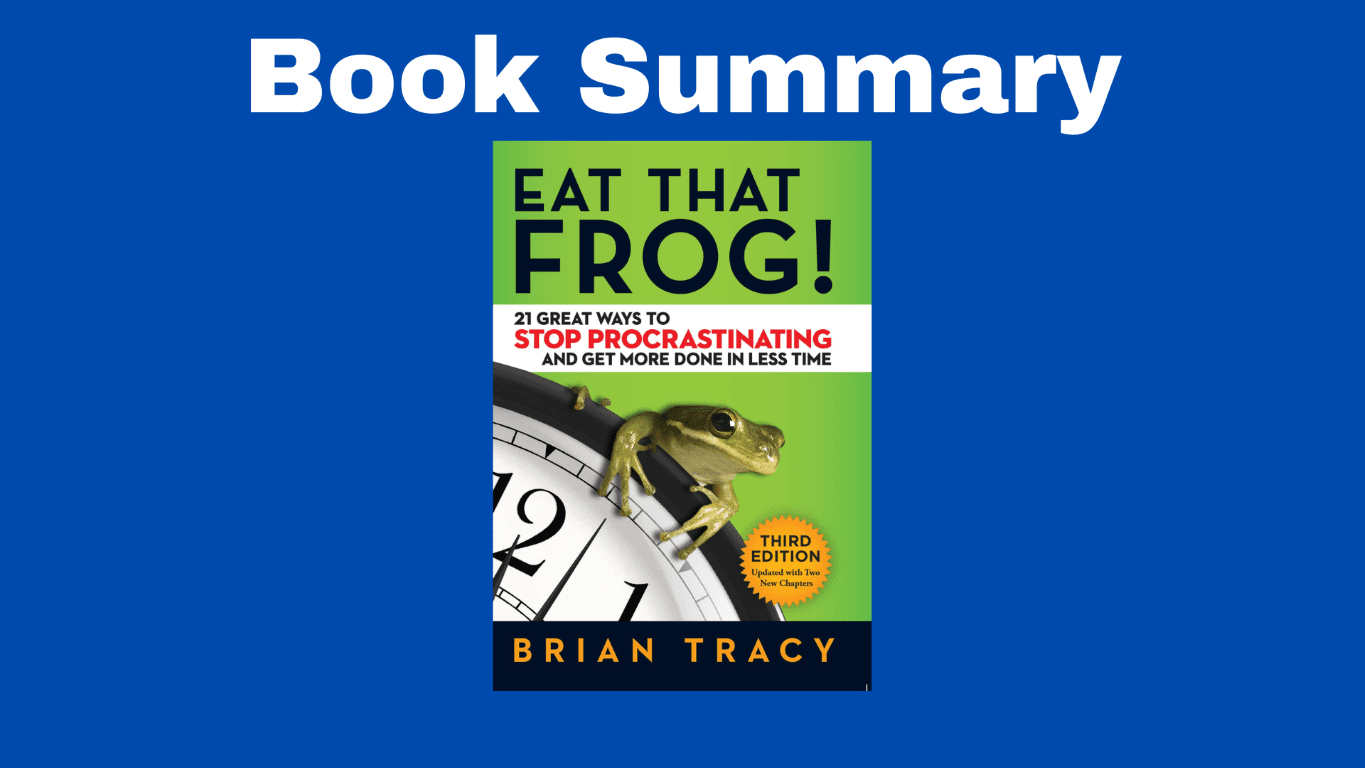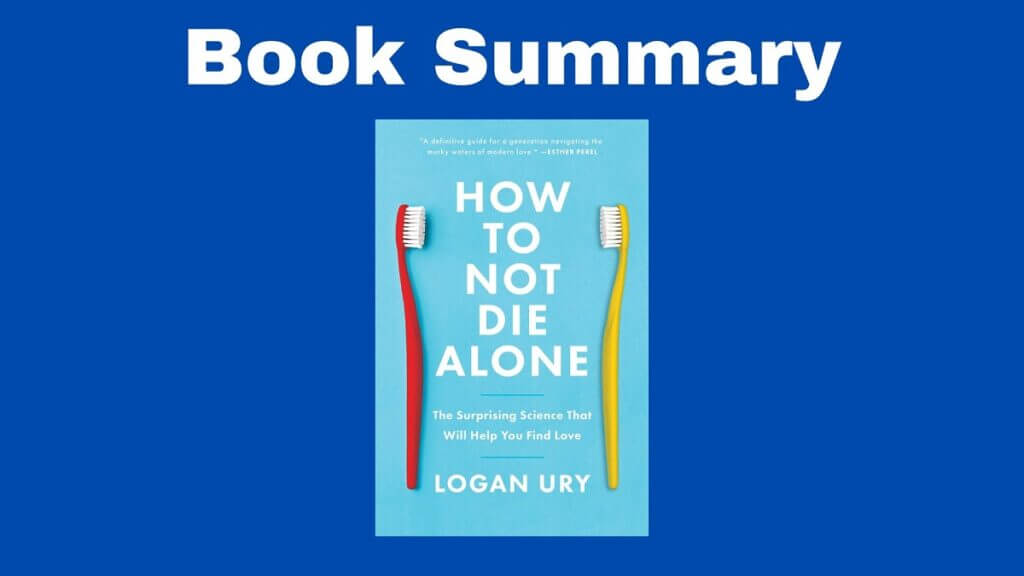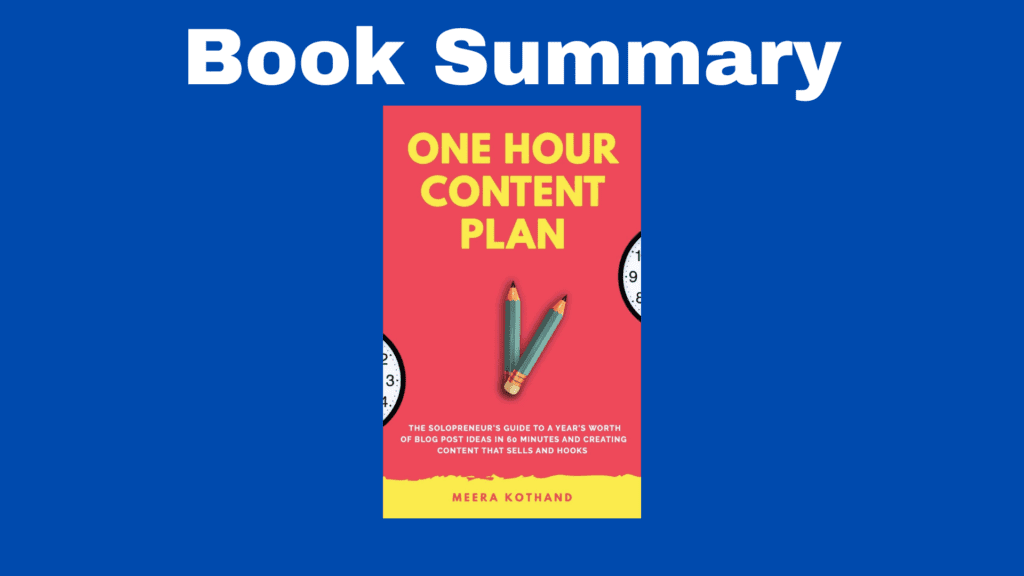The Book in Three Sentences
In this book summary of Eat That Frog, you’ll learn to stop procrastinating and get the most important tasks done. Working on your most important task will have the greatest positive impact on your life and the book revolves around that premise. The updated version of Eat that Frog features two new chapters.
Eat that Frog Summary
Concentrate single-mindedly on your most important task, do it well, and finish it completely. This is the key to great success, achievement, respect, status, and happiness.
Find what other people do and do the same things until you get the same results.
A frog is the biggest, most important task, the one you’re most likely to procrastinate. It’s also the one task that can have the greatest positive impact on your life.
Early on in the book, the author establishes two rules:
- If you have two frogs, eat the ugliest one first.
- If you have to eat a live frog, it doesn’t pay to sit and look at it for very long. Take action immediately.
Develop the habits of success: as you set priorities, overcome procrastination, and work on your most important task, this becomes a habit that gives you a positive feeling once you’re done.
Develop a positive addiction: completing the most difficult tasks first, gives you clarity, confidence, and competence.
Take no shortcuts to get there: it takes practice to get to your destination.
The three Ds of habit formation:
- Decision
- Discipline
- Determination.
Visualize yourself as you want to be: think constantly about the rewards of being focused and action-oriented.
Chapter 1: Set the Table
Have clarity when it comes to goals and objectives. The main reasons for procrastination and lack of motivation are vagueness and confusion. So think about what you’re trying to do, in what order, and for what purpose.
Steps to achieve your goals:
- Step 1: Decide exactly what you want.
- Step 2: Write it down
- Step 3: Set a deadline
- Step 4: Make a list of what you have to do to achieve your goal.
- Step 5: Organize the list into a plan.
- Step 6: Take action on your plan immediately.
- Step 7: Resolve to do something every single day that moves you toward your major goal.
Written goals motivate you into action and help you overcome procrastination
Chapter 2: Plan Every Day in Advance
Increase your return on your investment of mental, emotional, and physical energy. To do so, you should take around 10 minutes to plan the rest of your day on a piece of paper with a pen.
You can get as much as 120 minutes back simply by working from a list you wrote the night before. You should write different lists for different purposes, they include:
- A master list of everything you want to accomplish
- A monthly list
- A weekly list
- A daily list
Planning a project implies writing all the steps, prioritizing those steps, and then sequencing them.
Chapter 3: Apply the 80/20 Rule to Everything
The Pareto principle was created by an Italian economist called Vilfredo Pareto in 1985. According to this principle, people in society are divided into “the vital few”, the top 20% in terms of money and influence, and the “trivial many”, the bottom 80%. Pareto later discovered that this principle can be applied to all economic activity.
Even if a number of tasks take the same time to accomplish, some make a bigger impact on your life than others. The latter (these would be the “vital few” in Pareto’s law) are the ones that you should complete first. Similarly, the author suggests identifying low-value tasks so that you don’t procrastinate on them when you still need to work on important tasks first.
Motivation is a powerful tool you can use to overcome procrastination. Doing low-value tasks and important ones usually take the same amount of time, the difference is you get more satisfaction from completing the latter than the former.
Chapter 4: Consider the Consequences
A superior thinker is able to predict the consequences of doing or not doing something. The rule the author establishes is that “long-term thinking improves short-term decision-making.”
To make better decisions about time, ask yourself the potential consequences of either doing something or not doing it. Think about this in the long term because you can sacrifice time and effort now, to enjoy great rewards in the long run. Unsuccessful people, on the other hand, look for short-term pleasure completely disregarding the long-term future.
The Law of Forced Efficiency states that “there’s never enough time to do everything, but there’s always enough time to do the most important thing.” Some people strongly believe that they are better under the pressure of a deadline, but this isn’t true. People who have a strict deadline and have procrastinated on a task usually suffer more stress, are more likely to make mistakes and have to redo certain tasks.
Thinking about the following can make it easier for you when it comes to setting priorities, overcoming procrastination, and doing the most important activities:
- Think about your highest-value activities often.
- Focus on activities that make a difference.
- Use your time for the most valuable tasks first.
Chapter 5: Practice Creative Procrastination
You can’t do everything. Therefore, you have to procrastinate on something. You should consciously procrastinate on small tasks instead of important ones. Everyone procrastinates, but the difference is that high performers choose to procrastinate on different low-value activities while low performers procrastinate on high-value activities. Low-value activities should be outsourced, delegated, or eliminated.
The difference between priorities and posterities is that the former is something you do more of and sooner while the latter is something you do less of and later. So say no more often, especially to low-value activities. Say it politely, clearly, and regularly.
Most people do unconscious procrastination. You should avoid this at all costs. Instead, procrastinate on low-value tasks so that you have time for high-value ones. Remember that if something causes stress at home or work, that’s a sign that you shouldn’t do it as often.
Review your life and abandon time-consuming activities, such as watching TV or internet browsing. Replace these activities with spending time with your family, reading, exercising, or something that improves your quality of life.
Chapter 6: Use the ABCDE Method Continually
The ABCDE Method is a priority-setting technique. On a piece of paper, you write everything you have to do and you place a letter right next to each activity from A which represents the most important task you have to do, to E which represents the least important activity. Never do a B task when you haven’t tackled an A task. A is something you must do, B is something you should do, C is something that is nice to do, D is something that should be delegated, and E is something that should be eliminated.
Chapter 7: Focus on Key Result Areas
Clarity is essential for work, so always determine which skill will have the greatest positive impact on your life or career. Finding that answer is something that should guide your career from now on.
Chapter 8: Apply the Law of Three
Three tasks you perform are what contribute the most value to your business or company. You can take as little as 30 seconds to ask yourself your goals in life. The idea behind time management is to do more in less time at work so that you can spend more time at home with your family. So work all the time you work and don’t forget that your life should be balanced between your work life and your personal life.
Chapter 9: Prepare Thoroughly Before You Begin
You should have everything you need at hand before you begin working. Your workspace should be comfortable, clean, and organized. Preparation is important, but then you have to start immediately, so do the first thing that needs to get done.
Chapter 10: Take It One Oil Barrel at a Time
It’s possible to cross the Sahara desert (the biggest desert on the planet) by taking it one barrel at a time. The French marked the track with black, fifty-five-gallon oil barrels every five kilometers so that adventurers wouldn’t get lost. Break down the huge task in front of you into smaller, more manageable tasks.
Chapter 11: Upgrade Your Key Skills
Learn what you need to learn in order to do work effectively and efficiently. In other words, never stop learning. Identify what you need to do to do your job well and do it. The author identifies three steps to master something: read for at least one hour every day, take a course or seminar, and listen to audio programs about it. The more you learn, the more confident you’ll be.
Chapter 12: Identify Your Key Constraints
Between where you are right now and your objective there’s always something. Identify that limiting factor clearly. What’s holding you back? The 80/20 rule says that 80% of the constraints are internal and 20% external.
Chapter 13: Put the Pressure on Yourself
Don’t wait for something or someone to motivate you on your journey, you have to motivate yourself, so create your own deadlines and put pressure on yourself.
Chapter 14: Motivate Yourself into Action
Develop a routine to encourage yourself. Talk to yourself positively and refuse to complain.
Chapter 15: Technology Is a Terrible Master
When you feel the need to communicate constantly, technology becomes the enemy. Technology can be overwhelming and distracting. Disconnecting can lead to improved memory, and better sleep, among other benefits. Unsubscribe from newsletters, set up an autoresponder for email, and don’t be afraid to unplug from time to time.
Chapter 16: Technology Is a Wonderful Servant
Technology should be a tool, not something that controls you. It should make your life easier, not more difficult. To complete higher-value tasks, you have to stop doing lower-value ones and technology can help you remind yourself of the most important and protect you from the least important. Your digital workspace should be as clean as your physical workspace. Block distracting websites, the communication channels you have access to should be the ones that help you complete tasks, and disable notifications. Learn as much as you can when it comes to technology. If you’re going to use social media, post the progress you’ve made on a project as some form of reward for your hard work. Your posts shouldn’t be trite, post about your life goals.
Chapter 17: Focus Your Attention
The key to high performance is high attention. A lack of focus leads to failure. Avoid multitasking at all costs. People can only focus on one thing at a time. To avoid some of these issues don’t check email first thing in the morning, your devices should be off when you wake up, checking email should be done twice a day, and disable all sounds from your computer and phone.
To double your productivity: plan each day, choose the most important task, and start on that task as soon as you can. Work on that task for ninety minutes with no distractions and give yourself a fifteen-minute break. Work on that task for ninety more minutes. Reward yourself after working for three hours.
Chapter 18: Slice and Dice the Task
Procrastination happens because the task in front of us seems large. By cutting it down into smaller pieces, we make the task less formidable and more approachable. Develop a “compulsion to closure”. This will make you happy when you complete a task. Another technique involves working on the task at hand for as little as five to ten minutes. Once you start working on the task, you’ll build momentum and you won’t be able to stop until the task is complete.
Chapter 19: Create Large Chunks of Time
Important work requires you to find chunks of unbroken time to be productive. Discipline yourself to schedule these blocks of time and to keep them. To do so, you can keep a time planner to remind yourself of the block of time and you then turn off the phone, eliminate distractions, and work nonstop.
Chapter 20: Develop a Sense of Urgency
Highly productive people think, plan, and set priorities. But the most important quality they have is that they take action. They are in a hurry to complete their most important tasks. Once you start working on an activity, you enter a mental state called “flow”, this is where you work steadily, and with a sense of clarity. To trigger this state, you have to develop a sense of urgency which builds momentum.
Chapter 21: Single Handle Every Task
Once you start, keep going without distraction until the job is complete. Certain tasks take longer if you start them, leave them, and then have to pick them back again. Everything other than your task should be considered a waste of time, so train yourself to focus on one task at a time.
Further Reading
If you liked this summary of Eat That Frog, check out these articles:




